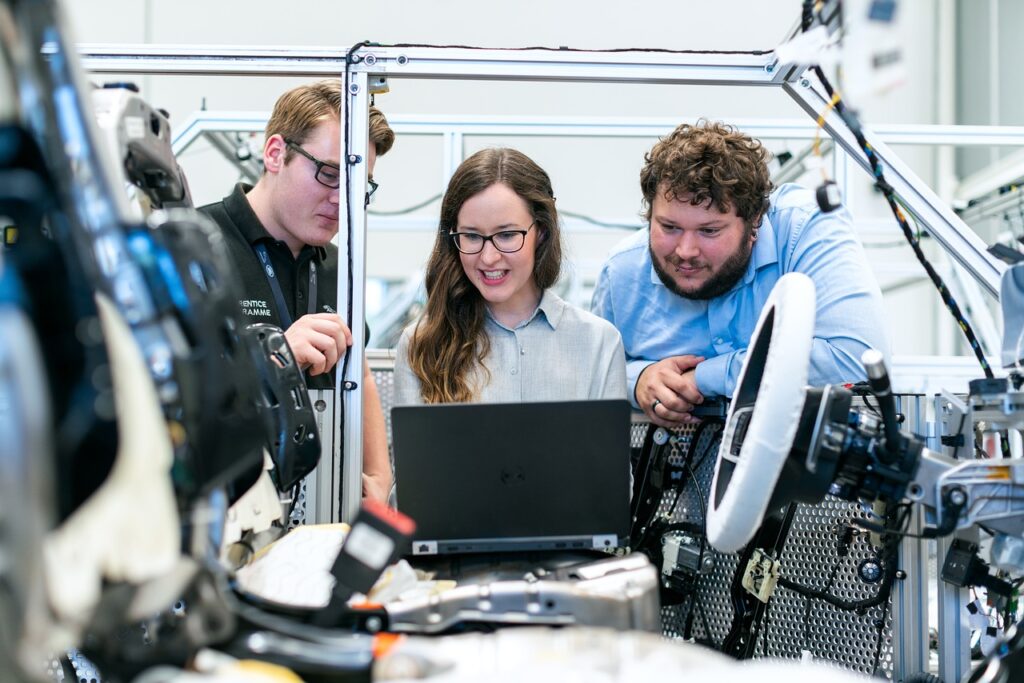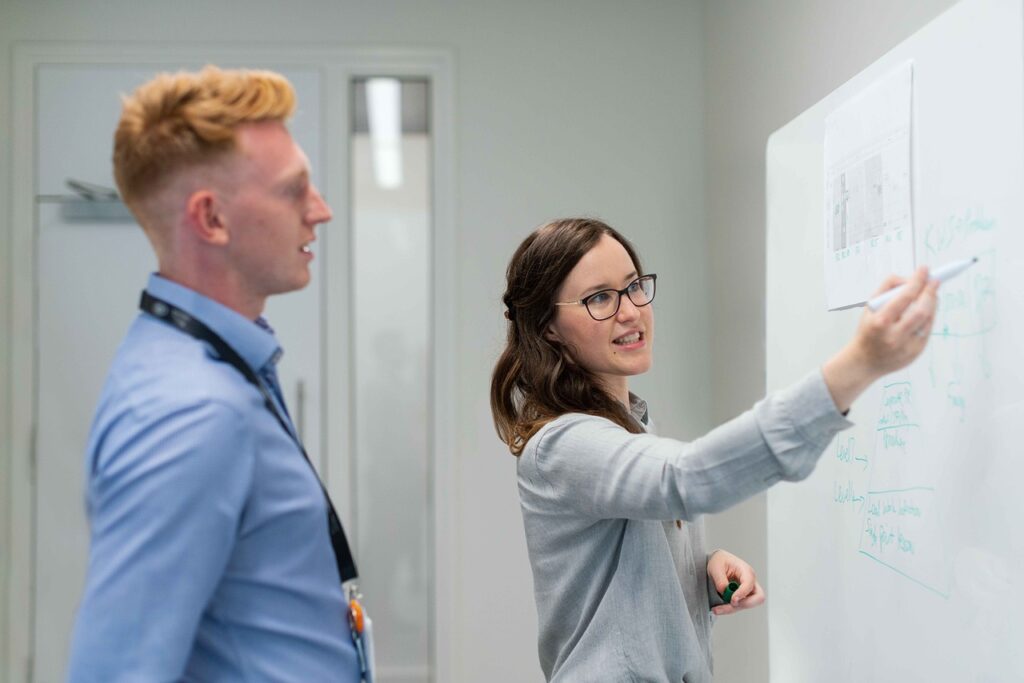Electrical engineering interview questions & ans
1.Why star delta starter is preferred with induction motor?
Ans. Star delta starter is preferred with induction motor due to following reasons:
• Starting current is reduced 3-4 times of the direct current due to which voltage drops and hence it causes less losses.
• Star delta starter circuit comes in circuit first during starting of motor, which reduces voltage 3 times, that is why current also reduces up to 3 times and hence less motor burning is caused.
• In addition, starting torque is increased and it prevents the damage of motor winding.
2.State the difference between generator and alternator?
Ans. Generator and alternator are two devices, which converts mechanical energy into electrical energy. Both have the same principle of electromagnetic induction, the only difference is that their construction. Generator persists stationary magnetic field and rotating conductor which rolls on the armature with slip rings and brushes riding against each other, hence it converts the induced emf into dc current for external load whereas an alternator has a stationary armature and rotating magnetic field for high voltages but for low voltage output rotating armature and stationary magnetic field is used.
Electrical engineering interview questions & ans
3.How can you relate power engineering with electrical engineering?
Ans. Power engineering is a sub division of electrical engineering. It deals with generation, transmission and distribution of energy in electrical form. Design of all power equipments also comes under power engineering. Power engineers may work on the design and maintenance of the power grid i.e. called on grid systems and they might work on off grid systems that are not connected to the system.

4.Why back emf used for a dc motor? highlight its significance?
Ans. The induced emf developed when the rotating conductors of the armature between the poles of magnet, in a DC motor, cut the magnetic flux, opposes the current flowing through the conductor, when the armature rotates, is called back emf. Its value depends upon the speed of rotation of the armature conductors. In starting, the value of back emf is zero.
5.What is slip in an induction motor?
Ans. Slip can be defined as the difference between the flux speed (Ns) and the rotor speed (N). Speed of the rotor of an induction motor is always less than its synchronous speed. It is usually expressed as a percentage of synchronous speed (Ns) and represented by the symbol ‘S’.
Electrical engineering interview questions & ans
6.What is Electrical Engineering, and explain its different applications?
Ans. Electrical Engineering is a branch of electrical systems and the application of its related electrical systems with electromagnetic or electronic subsystems.
The different applications are as below:
• Diodes, Rectifiers, and Transformers
• Digital Circuits
• DC or AC Motors
• DC or AC Generators
• Electrical Power Systems
• Electrical Control Systems
• Instrumentation Systems
• Communication Systems
• Digital and Analog Electronics
Electrical engineering interview questions & ans
6.What are the basic fundamental components of electrical circuits?
Ans. Below are the different basic
components –
• Active Circuits: Active Circuits are the elements that can generate energy from within their system as a form of source.
• Passive Circuits: Passive circuits are the elements that consume or allows the electric current to pass through it and does not generate any energy from it.
• AC or DC Circuits: AC is Alternating Current, and DC is Direct Current. AC will always produce some fluctuating current, whereas DC will always produce a stable current in the form of a constant source.
• Series or Parallel Circuits: Series Circuits are the circuits where the components are connected in series, and Parallel Circuits are the circuits where the components are connected in parallel.
Electrical engineering interview questions & ans
7.What are the different types of networks in building an electrical circuit?
Ans. This is the basic Electrical Engineering Interview Question asked in an interview. There are two types of electrical circuits called Passive or Active Networks. A Passive network is a network that contains passive elements in its network, such as Resistance, Capacitance, or Inductance. In contrast, an Active Network is a network that contains active elements in its network, such as Current or Voltage Sources.
Electrical engineering interview questions & ans
8.What is a Capacitor, Resistor, an Inductor?
Ans. Please find below the different tables that Electrical Engineering supports are. A Capacitor is an electrical component where it opposes the current flow and acts as a passive element, and stores some form of electrical charge when a potential is applied. A Resistor is an electrical component where it also opposes the flow of current and is a two-terminal component. It is mostly used to reduce the flow of current. An inductor is also an electrical component, also called a choke or coil, that is used to build electrical circuits and store the energy in the magnetic field.
Electrical engineering interview questions & ans
9.Why did you decide to become an electrical engineer? / What made you want to study electrical engineering?
Ans. The interviewers ask this question to check your passion for this engineering field, better understand your background, and figure out how they relate to each other. This is one of the primary and most asked electrical engineering interview questions. While answering this question, you should be ready to talk about your education, interest in engineering, and personal experiences in this field. Highlight your passion for the electrical engineering field and strictly avoid answers such as, “I knew engineers made good money” or “My parents wanted me to study electrical engineering.”

10.What would happen when two positively charged materials are placed together?
Ans. As we know that the positives repel and opposites attract. So, if you place two positively charged materials next to each other, the two materials will repel and move away.
11.What do you understand by reverse polarity? What is the process of fixing it?
Ans. Reverse polarity is a condition that occurs when the wires are incorrectly placed. For example, if the white wire connects to the hot side and the black wire connects to the neutral side. You can fix this problem by checking the connection of the wire from the outlet or checking the receptacle. You can solve the reverse polarity by swapping this entanglement.
Electrical engineering interview questions & ans
12.What are the different types of networks used to build an electrical circuit?
Ans. There are mainly two types of networks used to build an electrical circuit called Passive or Active Networks. A Passive network is a network that contains passive elements in its network, such as Resistance, Capacitance, or Inductance. On the other hand, an Active Network is a network that contains active elements in its network, such as Current or Voltage Sources.
13.How the tube light circuit is connected, and how does it work?
Ans. A choke is linked in one end of the tube light, and a starter is in sequence with the circuit. When supply is provided, the starter will break off the supply cycle of AC. Due to the unexpected alter of supply, the chock will make around 1000volts. This volt will be competent to break the electrons within the tube to make electron flow. Once the accessible pass through the pipe the appetizer circuit will be out of the part. Now there is no transform of supply causes choke voltage normalized and act as diminish the current.
Electrical engineering interview questions & ans
14.Tell me the advantages of speed control using thyristor?
Some of them are:
• Low cost
• High accurate
• Fast switching characteristics than BJT, IGBT
15.Explain 2 phase motor?
Ans. A two-phase motor is a coast with the starting winding, and the operation winding has a stage split e.g. ac servo motor. Where the auxiliary snaking and the manage winding have a stage split of 90 degrees.
Electrical engineering interview questions & ans
16.Explain RLC Circuit?
Ans. An RLC circuit carries out an electrical circuit consisting of a resistor (R) and the inductor (L) and a capacitor (C), linked in parallel. This circuit is known as a second-order circuit as any electrical energy or current in the circuit can be described by a next order discrepancy equation.
17.What are transistors comprised of?
Ans. Transistors are comprised of numerous combinations of n-type and p-type semiconductors.
18.What is a Zener diode?
Ans. Zener diode is a kind of semiconductor diode that permits existing to flow in the conflicting direction when uncovered to sufficient voltage.
Electrical engineering interview questions & ans
19.What is automatic voltage regulator?
Ans. AVR is a contraction for Automatic Voltage Regulator. It is a central part of Synchronous Generators; it controls the production voltage of the originator by controlling its excitation current. Thus it can direct the Reactive productivity Power of the Generator.
Electrical engineering interview questions & ans
20.What do you mean by frantic effect?
Ans. The output voltage is better than the effort voltage or getting end voltage is superior to the sending end voltage.
Electrical engineering interview questions & ans
Also read:-Civil Engineer Interview Questions and Answers
best of luck guys 👍
5 Comments on “Electrical engineering interview questions & ans”